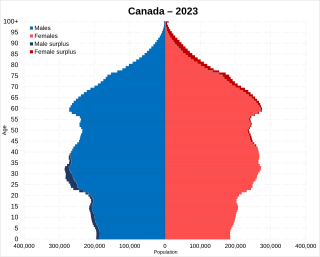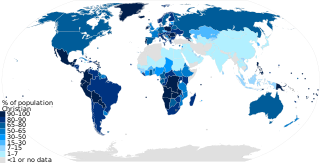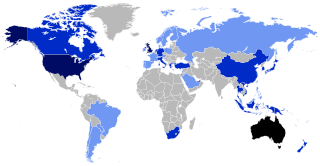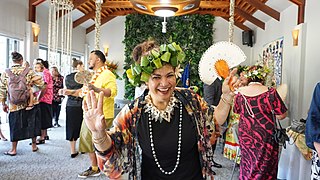
Statistics Canada conducts a country-wide census that collects demographic data every five years on the first and sixth year of each decade. The 2021 Canadian census enumerated a total population of 36,991,981, an increase of around 5.2 percent over the 2016 figure. It is estimated that Canada's population surpassed 40 million in 2023 and 41 million in 2024. Between 1990 and 2008, the population increased by 5.6 million, equivalent to 20.4 percent overall growth. The main driver of population growth is immigration. Between 2011 and May 2016, Canada's population grew by 1.7 million people, with immigrants accounting for two-thirds of the increase.

The demographics of New Zealand encompass the gender, ethnic, religious, geographic, and economic backgrounds of the 5.2 million people living in New Zealand. New Zealanders predominantly live in urban areas on the North Island. The five largest cities are Auckland, Wellington, Christchurch, Hamilton, and Tauranga. Few New Zealanders live on New Zealand's smaller islands. Waiheke Island is easily the most populated smaller island with 9,420 residents, while Great Barrier Island, the Chatham and Pitt Islands, and Stewart Island each have populations below 1,000. New Zealand is part of a realm and most people born in the realm's external territories of Tokelau, the Ross Dependency, the Cook Islands and Niue are entitled to New Zealand passports.
Anglo is a prefix indicating a relation to, or descent from England, English culture, the English people or the English language, such as in the term Anglosphere. It is often used alone, somewhat loosely, to refer to people of British descent in Anglo-America, the Anglophone Caribbean, South Africa, Namibia, Australia, and New Zealand. It is used in Canada to differentiate between French speaking Canadians (Francophones), located mainly in Quebec but found across Canada, and English speaking Canadians (Anglophones), also located across Canada, including in Quebec. It is also used in the United States to distinguish the Latino population from the non-Latino white majority.

Latvians are a Baltic ethnic group and nation native to Latvia and the immediate geographical region, the Baltics. They are occasionally also referred to as Letts, especially in older bibliography. Latvians share a common Latvian language, culture, history and ancestry.
This article details the geographical distribution of speakers of the German language, regardless of the legislative status within the countries where it is spoken. In addition to the Germanosphere in Europe, German-speaking minorities are present in many other countries and on all six inhabited continents.
Foreign-born people are those born outside of their country of residence. Foreign born are often non-citizens, but many are naturalized citizens of the country in which they live, and others are citizens by descent, typically through a parent.

As of the year 2023, Christianity had approximately 2.4 billion adherents and is the largest religion by population. According to a PEW estimation in 2020, Christians made up to 2.38 billion of the worldwide population of about 8 billion people. It represents nearly one-third of the world's population and is the largest religion in the world, with the three largest groups of Christians being the Catholic Church, Protestantism, and the Eastern Orthodox Church. The largest Christian denomination is the Catholic Church, with 1.3 billion baptized members. The second largest Christian branch is either Protestantism, or the Eastern Orthodox Church.
New Zealanders of European descent are mostly of British and Irish ancestry, with significantly smaller percentages of other European ancestries such as Germans, Poles, French, Dutch, Croats and other South Slavs, Greeks, and Scandinavians. European New Zealanders are also known by the Māori-language loanword Pākehā.

The Romanian diaspora is the ethnically Romanian population outside Romania and Moldova. The concept does not usually include the ethnic Romanians who live as natives in nearby states, chiefly those Romanians who live in Ukraine, Hungary, Serbia, and Bulgaria. Therefore, the number of all Romanians abroad is estimated at about 4–12 million people, depending on one's definition of the term "Romanian" as well as the inclusion respectively exclusion of ethnic Romanians living in nearby countries where they are indigenous. The definition of "who is a Romanian?" may range from rigorous conservative estimates based on self-identification and official statistics to estimates that include people of Romanian ancestry born in their respective countries as well as people born to various ethnic-minorities from Romania. As of 2015/16, over 97% of Romanian emigrants resided in OECD countries; and about 90% of Romanian emigrants in OECD countries lived in Europe, with the most common country of residence being Italy. The vast majority of Romanian emigrants are based in just ten countries, with the most common countries being Italy, Germany, Spain, United Kingdom, United States, Hungary, France and Canada.

British Columbia is a Canadian province with a population of about 5.6 million people. The province represents about 13.2% of the population of the Canadian population. Most of the population is between the ages of 15 and 49. About 60 percent of British Columbians have European descent with significant Asian and Aboriginal minorities. Just under 30% of British Columbians are immigrants. Over half of the population is irreligious, with Christianity and Sikhism being the most followed religions.

The Somali diaspora or Qurbajoogta refers to Somalis who were born in Greater Somalia and reside in areas of the world that they were not born in. The civil war in Somalia greatly increased the size of the Somali diaspora, as many Somalis moved from Greater Somalia primarily to Europe, North America, Southern Africa and Australia. There are also small Somali populations in other pockets of Europe and Asia. The UN estimates that in 2015, approximately 2 million people from Somalia were living outside of the country's borders.

Australians, colloquially known as Aussies, are the citizens, nationals and individuals associated with the country of Australia. This connection may be residential, legal, historical or ethno-cultural. For most Australians, several of these connections exist and are collectively the source of their being Australian. Australian law does not provide for a racial or ethnic component of nationality, instead relying on citizenship as a legal status.

Most of the 25-30 million followers of Sikhism, the world's fifth-largest religion, live in the northern Indian state of Punjab, the only Sikh-majority administrative division on Earth, but Sikh communities exist on every inhabited continent. Sizeable Sikh populations in countries across the world exist in India (20,833,116), Canada (771,790), England (520,092), the United States (~280,000), Italy (~220,000), and Australia (210,400), while countries with the largest proportions of Sikhs include Canada (2.12%), India (1.56%), Cyprus (1.1%) England (0.92%), New Zealand (0.87%), and Australia (0.83%).

Overseas Pakistanis, or the Pakistani diaspora, refers to Pakistanis who live outside of Pakistan. These include citizens that have migrated to another country as well as people born abroad of Pakistani descent. According to the Ministry of Overseas Pakistanis and Human Resource Development, approximately 8.8 million Pakistanis live abroad according to December 2017 estimates. According to the Ministry of Emigration and Overseas Employment, data released in 2023 states that more than 10.80 million people have moved abroad since 1990.

Overseas Indians, officially Non-Resident Indians (NRIs) and People of Indian Origin (PIOs) are Indians who reside or originate outside of India. According to the Government of India, Non-Resident Indians are citizens of India who currently are not living in India, while the term People of Indian Origin refers to people of Indian birth or ancestry who are citizens of countries other than India. Overseas Citizenship of India (OCI) is given to People of Indian Origin and to persons who are not People of Indian Origin but married to Indian citizen or People of Indian Origin. Persons with OCI status are known as Overseas Citizens of India (OCIs). The OCI status is a permanent visa for visiting India with a foreign passport.
This article details the geographical distribution of speakers of the Italian language, regardless of the legislative status within the countries where it is spoken. In addition to the Italian-speaking area in Europe, Italian-speaking minorities are present in few countries.

This article provides details regarding the geographical distribution of all Portuguese-speakers, a.k.a.Lusophones, regardless of legislative status. The Portuguese language is one of the most widely spoken languages in the world and is an official language of countries on four continents.
The article provides details and data regarding the geographicaldistribution of all Polish speakers, regardless of the legislative status of the countries where it's spoken. The Polish language is the dominant language of Poland and it's spoken in authochtonous minority areas through Europe and in many immigrant communities in all over the world.

Pasifika New Zealanders are a pan-ethnic group of New Zealanders associated with, and descended from, the indigenous peoples of the Pacific Islands outside of New Zealand itself. They form the fourth-largest ethnic grouping in the country, after European descendants, indigenous Māori, and Asian New Zealanders. Over 380,000 people identify as being of Pacific origin, representing 8% of the country's population, with the majority residing in Auckland.












